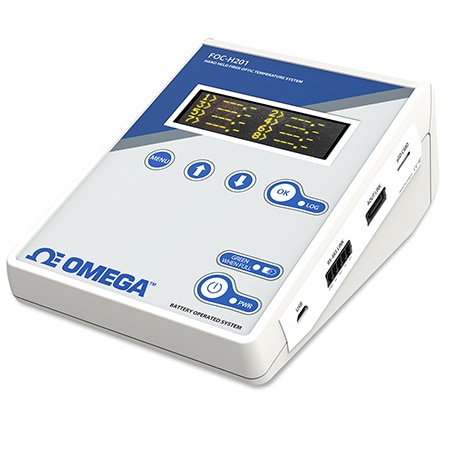1-800-663-4209 | Welcome to our new website, found an issue or bug? Please report it here
FOM-Series
-80 to 300 °C Fiber Optic Monitors
Models In Stock
- Temperature ranges from -80°C to 300°C
- Temperature monitors up to 8 channels
- Accuracy ± 1.0 °C (+/- 0.2 °C in relative temperature)
- Logging capabilities available through USB connectivity
FOM-Series
From
$
6,063.46
Models In Stock
Product Overview
- Accuracy ± 1 °C (± 1.8 °F)
- Accuracy Detail ± 1.0 °C (+/- 0.2 °C in relative temperature)
- Data Interface RS485, USB
- Data Interface Note RS-485 and USB output with Modbus
- Electrical Connection ST Connector
- Height 2.7 in
- Length 7.1 in
- Memory 2 TB
- Operating Temperature, Max 55 °C
- Operating Temperature, Min -40 °C
- Output Detail Optional external module (4-20 mA and 0-10 V, software selectable), with 8 programmable outputs
- Output Signal Current
- Portability Option Rechargeable battery (FOM-H201 version)
- Probe Compatibility All Omega fiber optic probes, most competitive GaAs probes
- Process Temperature, Max 300 °C
- Process Temperature, Min -80 °C
- Repeatability 0.2°C
- Resolution 0.1 °C
- Response Time, Max 0.5 sec
- Response Time, Min 0.2 sec
- Response Time Note Typically, 0.2 to 0.5 seconds per channel
- Supply Voltage 5 Vdc
- Width 4.9 in
The FOM-Series fiber optic monitors are designed to be compact and reliable. Fiber optic temperature measurement using the FOM-Series monitors provides accurate readings combined with a user friendly interface. The FOM-Series boasts a -80°C to +300°C temperature measurement range as well as ± 1.0°C (+/- 0.2°C in relative temperature) accuracy.
One of the greatest aspects of fiber optic temperature sensing is that the sensors do not require any recalibration. Fiber optic sensors have high repeatability, stability and no signal degradation due to probe length/lead length. The temperature measurement data can be datalogged to an Micro SD external memory card and sent to third party datalogger/system through RS-485 output or 0-10 V / 4-20 mA analog outputs.
These devices are used for various applications and environments. Common applications include transformer factories, chemical processing, medical equipment testing (MRI, PETSCAN, NMR), commercial grade microwave heating, food and beverage processing, electric vehicle and battery testing and wood drying.
Fiber optic sensors transfer information to the fiber optic monitor via light that travels through the fiber optic cable. This is quite different compared to traditional sensors that use resistance/voltage to communicate with monitors. Since fiber optic sensors use light the signal is very fast, reliable and is not influenced by outside forces such as EMI, RFI, NMR or microwave radiation.
PDFs & Manuals
Software & Drivers
